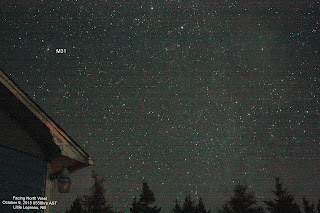Date Time: December 13, 2014 2100-2200hrs
Weather: Mostly clear with some passing clouds. Clouded over completely after about 2210hrs. No wind 0C with a reported windchill of -4C.
Attendance: Ed O., David M.
Equipment: Canon Rebel Xsi with 18-55mm lens on tripod.
Objective: To view and image as many shooting stars as possible. This night was reported to be the peak of the 2015 Geminid Meteor Shower.
Highlights:
- My wife Carla and I both seen a shooting star on our drive home, about 30 minutes before observing time.
- Ed set his lawn chair so that he could watch to the North in the direction of the Big Dipper, Cepheus and Cassiopeia. I set my lawn chair up and the camera so that Orion and Taurus area was covered.
- Over the hour, Ed and I counted 22 Geminids and 2 Sparadics. We agreed that the Geminids were slow moving but disagreed on the color. Ed thought they looked greenish where I thought they looked more dark orange/yellowish. They were notably slow moving with at least a couple looking like they changed direction.
- Ed noticed that most of the ones he seen went in a sort of lane-way between Cepheus and Cassiopeia.
- Most of the Geminds I seen were to the lower left and lower right of Orion, with one pass right through the bottom part of the great hunter. Of course, they all came from the direction of Gemini.
- I witnessed two sparadics which came from high over head to the East straight down almost at Gemini. Both were much faster shooting stars and one was a very bright blue.
- Over the course of the observing hour, imaged the whole hour in 25 second images. Stitched the images together in PIPP program to make this 1 minuite video of the hour. Only one Geminid was captured by video and it was faint.
- One Satellite was captured in the images.
Images:





















































